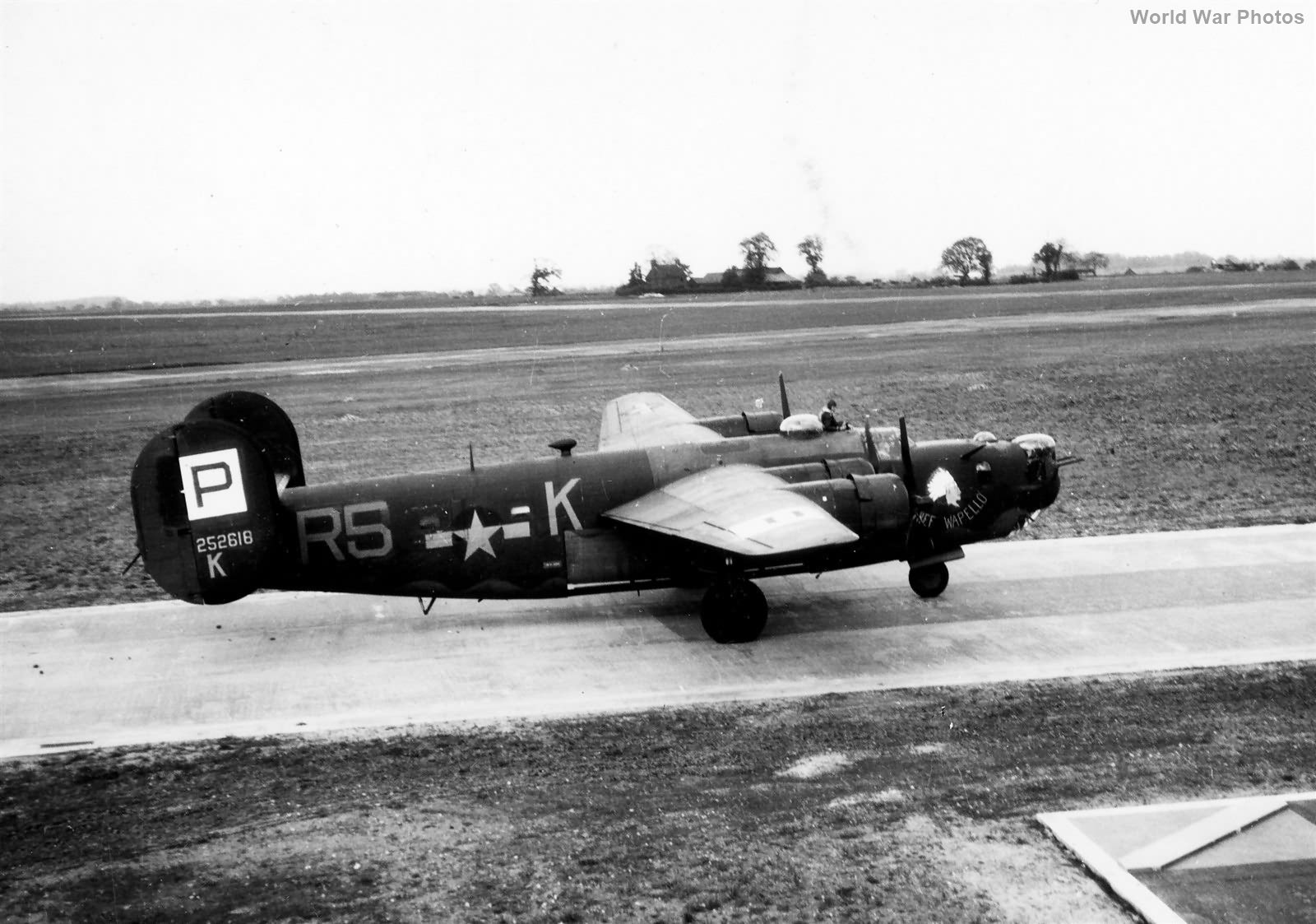487th Bombardment Group (Heavy):
Overview and Command Assignments
- Assigned to Eighth Air Force: April 1944 – August 1945
- Wing & Command Assignments:
- 3rd Bombardment Division (BD), 92nd Combat Bomb Wing (CBW): 5 April 1944
- 3rd BD, 4th Bomb Wing (P): 22 November 1944
- 3rd Air Division (AD), 4th Bomb Wing (P): 1 January 1945
- 3rd AD, 4th CBW: Approximately 16 February 1945
Component Squadrons
- 836th Bombardment Squadron (H)
- 837th Bombardment Squadron (H)
- 838th Bombardment Squadron (H)
- 839th Bombardment Squadron (H)
Combat Aircraft
- B-24H Liberator: From block 15, used until 19 July 1944.
- B-24J Liberator: Used until 19 July 1944.
- B-17G Flying Fortress: From block 75-BO, in combat from 1 August 1944.
Station
- Lavenham, England: 4 April 1944 – 24 August 1945 (Air echelon arrived between 13-17 April 1944)
Group Commanding Officers (CO)
- Lt Col Beirne Lay Jr.: 28 February 1944 – 11 May 1944 (MIA, evaded capture)
- Col Robert Taylor III: 12 May 1944 – 27 December 1944
- Col William K. Martin: 28 December 1944 – May 1945
- Col Nicholas T. Perkins: 3 June 1945 – August 1945
- (Lt Col Howard C. Todt served as acting CO from May 1945 – 2 June 1945)
Mission Details
- First Mission: 7 May 1944
- Last Mission: 21 April 1945
- Total Missions: 185 (46 with B-24s)
- Total Credit Sorties: 6,021
- Total Bomb Tonnage: 14,041.4 tons (including 158.1 tons of supplies, etc.)
- Aircraft Missing in Action (MIA): 48
- Other Operational Losses: 37
- Enemy Aircraft Claims: 22 destroyed, 6 probably destroyed, 18 damaged
Claims to Fame
- Led Largest Eighth Air Force Mission: On 24 December 1944, the group led the largest mission of the war.
- Bombing Accuracy: Led the 3rd Air Division in bombing accuracy from January 1945 to the end of the war, with strikes within 1,000 feet of the Mean Point of Impact (MPI).
History
- Activated: 20 September 1943 at Bruning Army Air Field, Nebraska.
- Training:
- Moved to Alamogordo Army Air Field, New Mexico, on 15 December 1943 to complete training.
- The ground echelon departed Alamogordo on 10 March 1944 for Camp Kilmer, New Jersey, and sailed on the Duchess of Bedford on 23 March 1944, arriving in Gourock, Scotland, on 3 April 1944.
- The air echelon began its overseas movement on 23 March 1944, taking the southern ferry route to the UK and arriving at Nuts Corner, Valley, and Prestwick in early April 1944.
- Redeployment to the USA:
- Aircraft left Lavenham during the first week of July 1945.
- The ground echelon sailed from Southampton on the Queen Elizabeth on 25 August 1945, arriving in New York on 1 September 1945.
- Personnel had 30 days R&R.
- The group was established at Drew Field, Florida, on 3 September 1945 and was inactivated there on 7 November 1945.
Aircraft Markings and Color Schemes
B-24 Liberators (April – July 1944)
Original Paint Scheme:
- Dark Olive Drab and Neutral Gray factory finish.
- Square P Group Marking:
- Vertical Tail: 48-inch white square with a 36-inch high blue “P” in the center.
- Wing: Mostly 72 inches square with a 57-inch chord, in the same colors as the tail.
- Call-Letter: 24 inches high in yellow, painted under the tail number. Each squadron used letters from A in alphabetical order, excluding I.
Squadron Codes:
- 48 inches high in light grey, painted on the rear fuselage:
- 836th Bomb Squadron: 2G
- 837th Bomb Squadron: 4F
- 838th Bomb Squadron: 2C
- 839th Bomb Squadron: R5
- On natural metal-finish B-24s, the squadron codes and call-letters were in black, with the Square P in white on a black background.
- 48 inches high in light grey, painted on the rear fuselage:
B-17 Flying Fortresses (July 1944 – August 1945)
Paint Scheme:
- Natural Metal Finish.
- Square P Group Marking:
- Vertical Tail: 48-inch white square with a 36-inch high blue “P.”
- Wing: Mostly 57 inches square with a 48-inch letter.
- Tail Call-Letter: 24 inches high in black.
- Fuselage Codes and Call-Letter: Black, mostly 36 inches high, with variable positioning. The most common layout was the squadron code aft of the waist gun position on the left side of the fuselage with the call-letter forward of the national insignia. On the right side, the squadron codes were mostly positioned forward of the national insignia, with the call-letter on the rear fuselage. However, there was no standard position for these markings, and variations occurred.
Special Markings:
- December 1944: The 4th Combat Bomb Wing chevron marking was painted on the upper surface of the right wing and the under surface of the left. The inner arm was yellow and the outer arm red, each 48 inches wide.
- January 1945: Introduction of the 4th CBW yellow tail surfaces and wing tips scheme. The Group markings and tail number were not obscured, but the call-letter was and was not reinstated. Fuselage markings remained unchanged as there was no requirement for colored stripes.
- March 1945: Some aircraft of the 839th Bomb Squadron featured red engine cowlings, while others in the same squadron had red chin turrets. The 837th Bomb Squadron began painting its engine cowlings yellow, and most aircraft had received this decoration by VE-Day.
